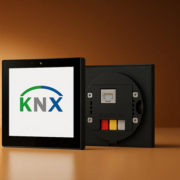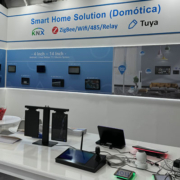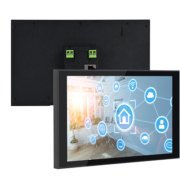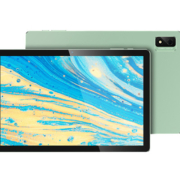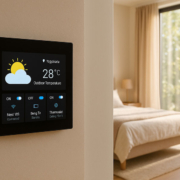Developing Smart Home Touchscreen Control Panel
As smart homes continue to rise in popularity, the need for intuitive and centralized control systems becomes increasingly critical. A Smart Home Touchscreen Control Panel is at the heart of this ecosystem, offering users a seamless and user-friendly interface to control various smart devices, such as lights, thermostats, security cameras, and entertainment systems. But how do you go about developing a reliable, feature-rich control panel that integrates smoothly into a smart home environment?
In this article, we will explore the essential steps and technologies involved in developing a Smart Home Touchscreen Control Panel, and highlight how Portworld provides the perfect foundation for building these smart, intuitive interfaces.
1. Understanding the Role of a Smart Home Touchscreen Control Panel
A Smart Home Touchscreen Control Panel acts as the brain of the home automation system. It centralizes control of all connected devices, making it easy for users to monitor and manage various elements of their environment from a single interface. These devices can include:
- Lighting: Adjusting brightness, color, and scheduling
- HVAC Systems: Setting temperature and humidity levels
- Security Systems: Monitoring cameras, unlocking doors, setting alarms
- Entertainment: Controlling audio, video, and other entertainment equipment
- Shades and Curtains: Automating window treatments based on time or occupancy
The control panel is typically wall-mounted for easy accessibility, and the touch interface offers a simple yet powerful way to interact with the system.
2. Key Features of a Smart Home Touchscreen Control Panel
When developing a smart home control panel, several factors must be considered to ensure a smooth, intuitive experience. These features include:
User-Friendly Interface
The control panel should feature a clean, responsive, and intuitive UI/UX, allowing users to quickly access and control devices with minimal effort. Multi-touch functionality, custom layouts, and easy navigation are essential for ensuring that users can operate the system without frustration.
High-Quality Display
A high-definition touchscreen is critical for both visual appeal and user experience. Panels should offer excellent brightness, resolution, and color accuracy, allowing users to easily read information and make precise selections.
Integration with Smart Devices
A smart home control panel must support integration with a wide variety of smart devices, including smart lights, locks, security cameras, and thermostats. Protocol compatibility with systems like KNX, Zigbee, Z-Wave, and Wi-Fi is essential for seamless communication.
Automation Capabilities
The panel should enable users to create customized automation scenarios — for example, setting up “Good Morning” routines that adjust the thermostat, turn on the lights, and open the blinds. It should support time-based schedules and conditions such as motion detection or occupancy status.
Voice Integration
With voice assistants like Alexa, Google Assistant, and Siri becoming increasingly popular, integrating voice control into the system can offer users a hands-free option for controlling their home.
Remote Access
Smart home control panels should allow for remote access via smartphones or tablets, enabling users to monitor and control their devices from anywhere, anytime. This can be achieved through mobile apps or cloud-based solutions.
3. Choosing the Right Hardware
The hardware foundation of the control panel is crucial to ensuring performance, reliability, and longevity. Key elements include:
Display Size and Resolution
Portworld offers a range of touchscreen panels in sizes ranging from 5.5 inches to 14 inches, with high-resolution IPS displays for excellent color accuracy and viewing angles. The size should match the intended use — for a wall-mounted system, 10-14 inches is ideal for clear visibility and easy interaction.
Processor and Performance
The panel’s processor must be powerful enough to handle multiple tasks simultaneously, including controlling devices, running automation scenarios, and updating real-time data. Portworld’s panels feature Rockchip RK3566/RK3568 processors, which provide high processing power while maintaining energy efficiency.
Connectivity Options
The panel should support a range of communication protocols such as Wi-Fi, Bluetooth, PoE (Power over Ethernet), and RS485, enabling integration with a wide variety of smart home devices. Portworld’s control panels come with built-in support for Wi-Fi 6, Bluetooth 5.2, and PoE, ensuring robust and reliable connections.
Power Efficiency
To ensure the panel operates efficiently over time, power-saving features should be incorporated. With PoE integration, Portworld’s control panels provide both power and data transmission over a single cable, simplifying installation and minimizing power consumption.
4. Software Development and Integration
The software running on the control panel is just as important as the hardware. Here are the key considerations for developing the software side:
Operating System (OS)
Portworld’s panels support Android 11, Ubuntu, and Debian. These flexible operating systems allow for custom development and integration with third-party applications, making it easy to build tailored solutions for smart home users.
Customizable UI/UX
A well-designed user interface is essential for ensuring ease of use. With Portworld’s SDK/BSP, developers can create custom themes, interactive controls, and personalized layouts that match the unique requirements of the user or brand.
Automation and Scheduling
The system should allow users to easily create automation rules based on time, conditions, or triggers. For example, users can automate lighting to turn on at sunset, adjust the thermostat based on occupancy, or activate security cameras when motion is detected.
Security and Data Protection
Security is paramount in smart home systems. The control panel should include end-to-end encryption, secure boot mechanisms, and over-the-air (OTA) updates to ensure that the system remains safe and up to date.
5. Why Portworld is the Perfect Partner for Your Smart Home Panel
Portworld offers everything you need to develop a top-tier smart home touchscreen control panel. With customizable hardware, flexible software platforms, and industry-leading support, Portworld provides a comprehensive solution for developers looking to create cutting-edge smart home interfaces.
- Full Customization: Customizable display size, casing design, and branding
- OEM/ODM Services: Tailor the panel’s functionality and design to your specific needs
- Comprehensive Support: Full SDK/BSP support and integration with Android/Linux ecosystems
- Robust Performance: Powered by Rockchip RK3566/RK3568 SoCs, offering top-notch processing and connectivity
- Future-Proofing: Support for evolving technologies like AI and voice control
Portworld’s embedded systems provide a reliable foundation for building the smart home control panel of the future.


